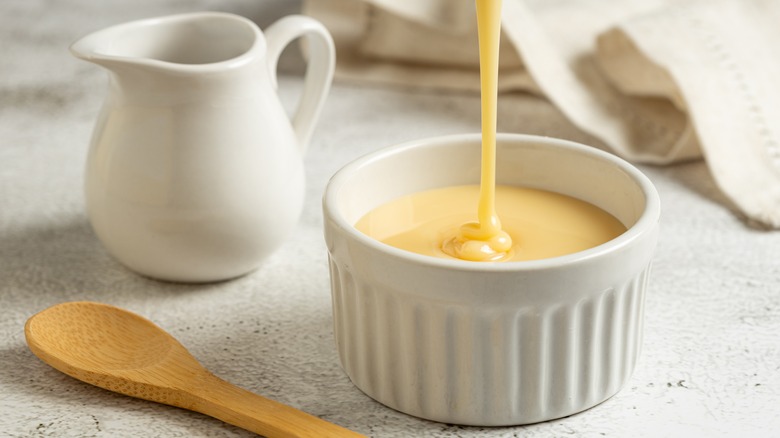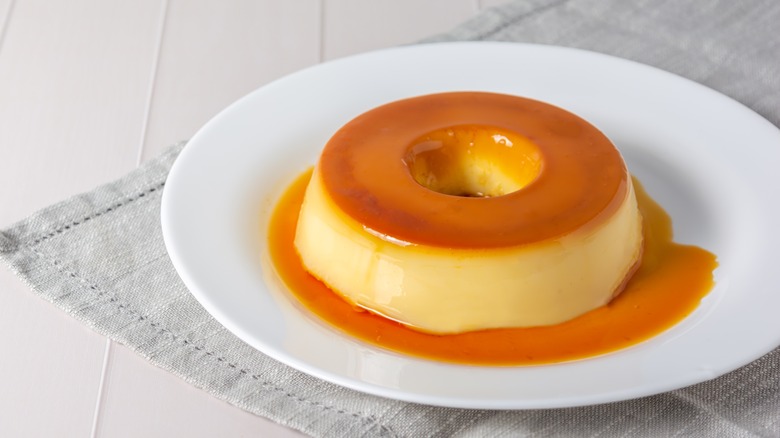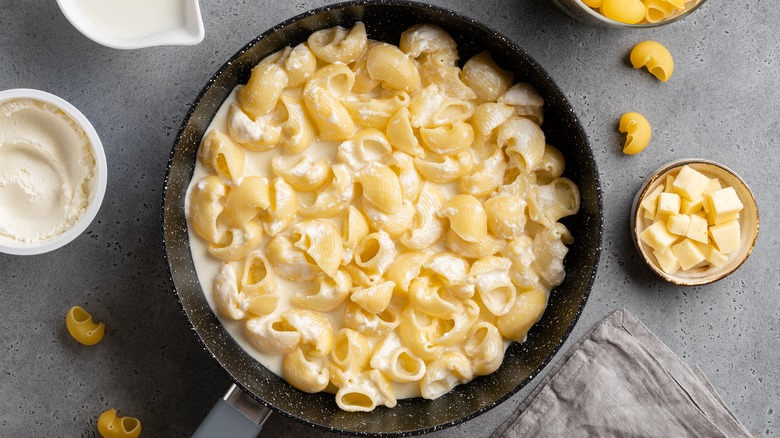Condensed Vs Evaporated Milk: What's The Difference?
Have you ever wondered if you can substitute evaporated milk for sweetened condensed milk, or vice-versa? When you've got a hankering for dulce de leche made with condensed milk or sweet potato pie made with the evaporated stuff, but the store is sold out of what you need, this swap certainly sounds tempting. But unfortunately, the answer is no — these canned dairy products have key distinctions in flavor, texture, and taste, making them far from interchangable.
Though both of these foods use a base of milk that is simmered to cook off about 60% of the water, the big difference lies in condensed milk's added sugar content. Evaporated milk is simply cooked down, homogenized, and preserved in a can, but the condensed version simmers sugar with the milk until it thickens (notably, "condensed milk" and "sweetened condensed milk" are two names for the same thing). The result is a creamy dairy product that is much more viscous and concentrated than evaporated milk, with a caramelized depth of taste from browning the sugar.
Evaporated milk's flavor is pretty similar to regular milk, with some sweet "cooked" notes, but no sugar rush. The milk does reduce via cooking, but is still relatively thin, similar in texture to half and half. For this reason, you can easily swap in evaporated milk in many recipes that call for milk or cream, but you'll want to use condensed milk more sparingly because of its sweetness and density.
Condensed milk imparts caramelized sweetness to recipes
When you pour out a can of sweetened condensed milk, you'll quickly notice its creamy thickness. Due to its concentrated nature, a little bit goes a long way in terms of both flavor and texture. You can whisk this caramelized, luxurious dairy product into morning beverages in place of milk, such as in Vietnamese iced coffee or a banana smoothie. Drizzle condensed milk onto fresh sliced fruit for a sweet yet refreshing summer dessert. And one of the most popular uses, of course, is to make dulce de leche by cooking the milk down further with more sugar.
When cooking or baking with condensed milk, be sparing. Unless you're making a dish where it's a key ingredient — like flan, for instance — you usually just need a small amount to give recipes a richer, sweeter dairy twist. And when adding this ingredient to recipes where it wasn't originally called for, reduce the amount of additional sugar. For goods like cakes, pancakes, or cookies, replace just a tablespoon of the milk in the batter with condensed milk for extra richness. You can even mix a spoonful or two into your favorite frosting recipe to make it even more creamy.
Evaporated milk is more versatile in savory and sweet applications
You're more likely to see evaporated milk in savory recipes like mac and cheese, curries, or hearty stews. The lack of extra sugar makes it far more versatile. Since the milk has been cooked down and reduced, it's less likely to curdle over heat when making creamy sauces. It also has a thicker mouthfeel, which makes it ideal for soups; you won't have to simmer the pot for as long to get a richer texture, compared to using regular milk.
On the sweet side, evaporated milk is a key ingredient in classic baked treats from pumpkin pies to puddings and cookie bars. While sweetened condensed milk is used to impart extra richness to creamy confections like fudge, evaporated milk functions more like regular milk: It adds moisture and protein to baked goods, custards, and more, with a less obvious sugary taste.
While you can't swap condensed milk for evaporated, there are baked goods that benefit from the addition of both. Take tres leches cake, which is famously made with regular, condensed, and evaporated milk. And if you don't have a can of whichever dairy product you need, you can make evaporated or sweetened condensed milk at home by gently simmering regular milk down in a saucepan. Just don't forget to add plenty of sugar when making the condensed version.



